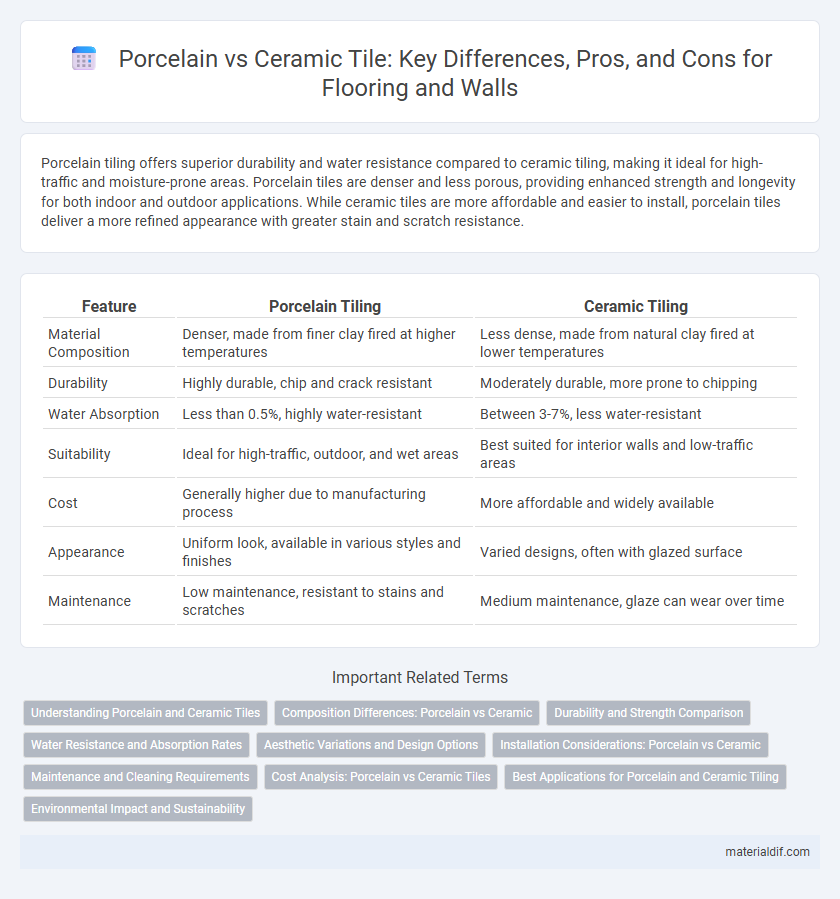Porcelain tiling offers superior durability and water resistance compared to ceramic tiling, making it ideal for high-traffic and moisture-prone areas. Porcelain tiles are denser and less porous, providing enhanced strength and longevity for both indoor and outdoor applications. While ceramic tiles are more affordable and easier to install, porcelain tiles deliver a more refined appearance with greater stain and scratch resistance.
Table of Comparison
| Feature | Porcelain Tiling | Ceramic Tiling |
|---|---|---|
| Material Composition | Denser, made from finer clay fired at higher temperatures | Less dense, made from natural clay fired at lower temperatures |
| Durability | Highly durable, chip and crack resistant | Moderately durable, more prone to chipping |
| Water Absorption | Less than 0.5%, highly water-resistant | Between 3-7%, less water-resistant |
| Suitability | Ideal for high-traffic, outdoor, and wet areas | Best suited for interior walls and low-traffic areas |
| Cost | Generally higher due to manufacturing process | More affordable and widely available |
| Appearance | Uniform look, available in various styles and finishes | Varied designs, often with glazed surface |
| Maintenance | Low maintenance, resistant to stains and scratches | Medium maintenance, glaze can wear over time |
Understanding Porcelain and Ceramic Tiles
Porcelain tiles are denser, less porous, and fired at higher temperatures than ceramic tiles, making them more durable and water-resistant, ideal for high-traffic and moisture-prone areas. Ceramic tiles offer greater design variety and are easier to cut, often preferred for indoor wall applications and lighter foot traffic spaces. Both tile types are made from clay but differ significantly in composition and manufacturing processes, influencing their performance and cost-effectiveness in various installations.
Composition Differences: Porcelain vs Ceramic
Porcelain tiling is made from finer, denser clay and fired at higher temperatures compared to ceramic tiling, resulting in increased durability and lower porosity. Ceramic tiles consist of a mixture of red or white clay with other natural materials, making them more porous and less resistant to moisture. These composition differences make porcelain tiles ideal for high-traffic areas and external environments, whereas ceramic tiles are better suited for indoor, low-traffic spaces.
Durability and Strength Comparison
Porcelain tiling offers superior durability and strength compared to ceramic tiling, making it ideal for high-traffic areas and commercial spaces due to its dense, low-porosity composition. Porcelain's resistance to scratches, chips, and moisture surpasses that of ceramic tiles, which are more prone to wear and damage over time. In terms of longevity and maintenance, porcelain tiles provide a more robust and reliable flooring solution.
Water Resistance and Absorption Rates
Porcelain tiling boasts significantly lower water absorption rates, typically less than 0.5%, compared to ceramic tiles which can absorb up to 7%, making porcelain ideal for moisture-prone areas such as bathrooms and kitchens. This superior water resistance enhances durability and reduces the risk of mold and mildew growth, extending the tile's lifespan in wet environments. Porcelain's dense, vitrified composition ensures minimal water penetration, whereas ceramic tiles, being more porous, require additional sealing for optimal water resistance.
Aesthetic Variations and Design Options
Porcelain tiling offers a wider range of aesthetic variations and design options due to its denser composition, allowing for more intricate patterns and realistic textures that mimic natural stone or wood. Ceramic tiles, while versatile, generally provide fewer design options with glossier finishes and less detailed surface patterns. Porcelain's superior durability enables the incorporation of diverse colors and finishes without compromising longevity, making it ideal for high-traffic or stylish interior spaces.
Installation Considerations: Porcelain vs Ceramic
Porcelain tiling requires precise cutting tools and a slower installation process due to its density and hardness, whereas ceramic tiles are easier to cut and install, making them suitable for DIY projects. The subfloor for porcelain must be perfectly leveled to prevent cracking, while ceramic tiles offer more flexibility with minor surface imperfections. Porcelain's higher water absorption resistance demands specific adhesives and grouts for optimal durability, contrasting with the more forgiving installation requirements of ceramic tiles.
Maintenance and Cleaning Requirements
Porcelain tiling requires less maintenance and cleaning compared to ceramic tiling due to its denser composition and lower porosity, making it highly resistant to stains and moisture. Ceramic tiles often need more frequent sealing and are more susceptible to absorbing spills and dirt, necessitating regular deep cleaning. Both materials benefit from routine sweeping and mopping, but porcelain's durability significantly reduces long-term upkeep efforts.
Cost Analysis: Porcelain vs Ceramic Tiles
Porcelain tiles generally cost between $3 and $10 per square foot, making them more expensive than ceramic tiles, which range from $1 to $5 per square foot. The higher price of porcelain is due to its denser composition, superior durability, and lower water absorption rate. Installation costs can also be higher for porcelain because of its hardness, requiring specialized tools and labor.
Best Applications for Porcelain and Ceramic Tiling
Porcelain tiling excels in high-traffic areas and outdoor spaces due to its density, low porosity, and resistance to moisture and stains, making it ideal for kitchens, bathrooms, and patios. Ceramic tiling is best suited for indoor walls and low-traffic areas, offering a wider variety of designs and easier installation at a lower cost. Both materials provide durable and aesthetically pleasing options, but porcelain's strength and water resistance give it an edge in more demanding environments.
Environmental Impact and Sustainability
Porcelain tiling demonstrates superior environmental sustainability compared to ceramic tiling due to its longer lifespan and higher durability, reducing the frequency of replacements and waste generation. Porcelain tiles are typically fired at higher temperatures, resulting in lower porosity and better resistance to moisture, which decreases the need for chemical sealants and maintenance. The energy-intensive manufacturing process of porcelain is offset by its eco-friendly longevity and the potential for recycling, making it a more sustainable choice in the long term.
Porcelain Tiling vs Ceramic Tiling Infographic

 materialdif.com
materialdif.com